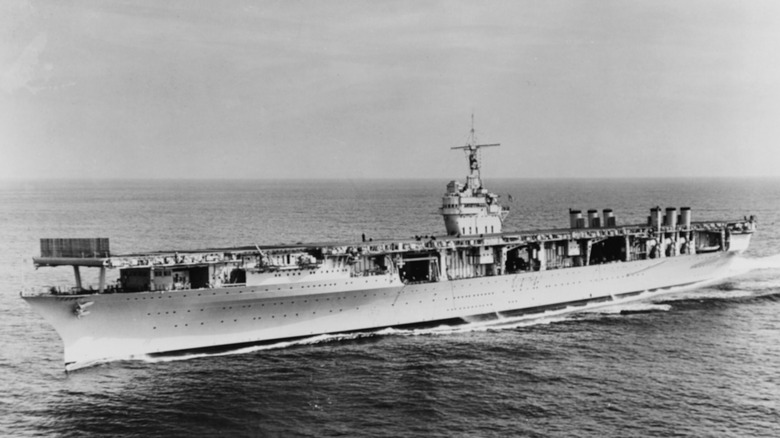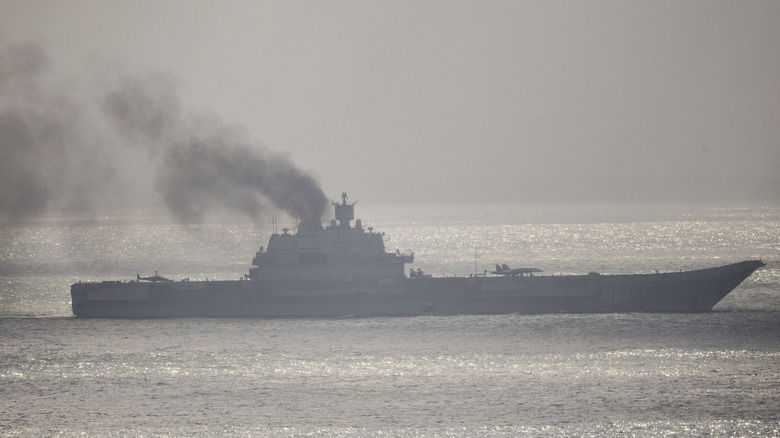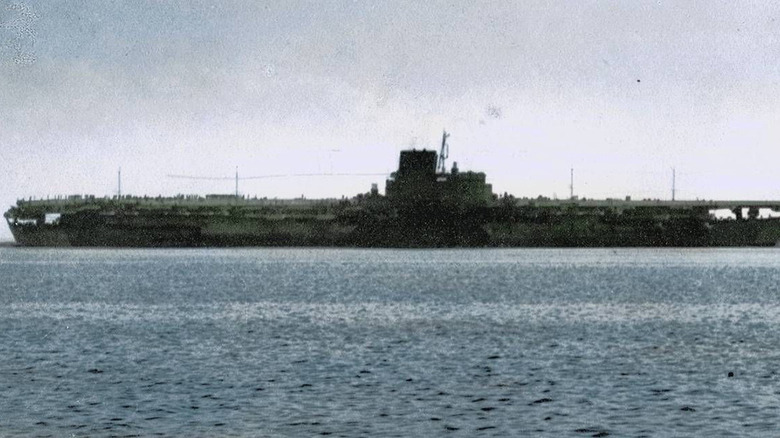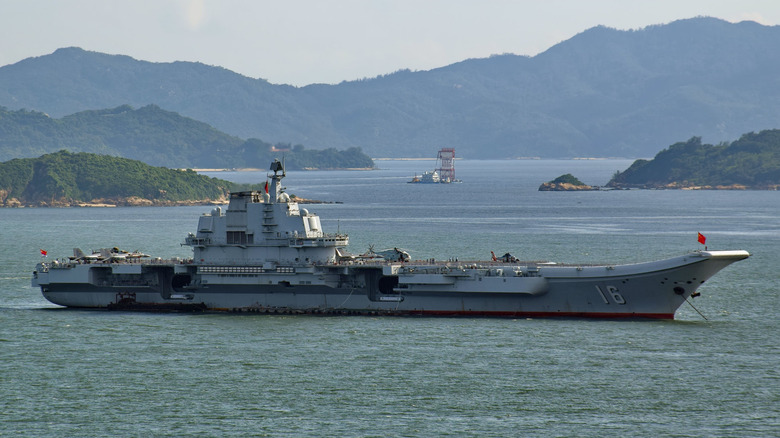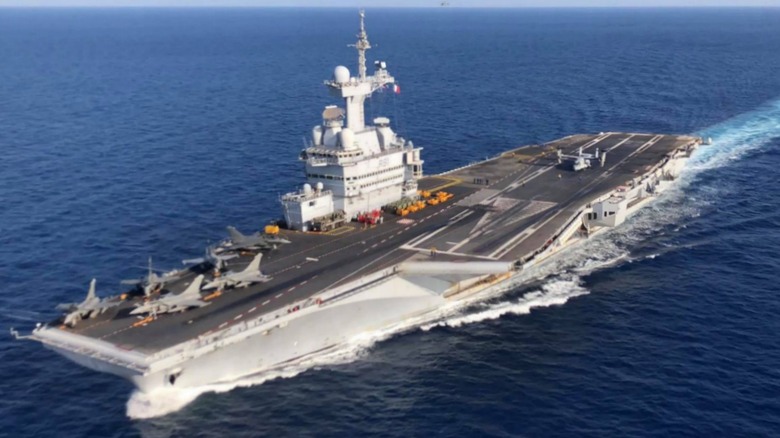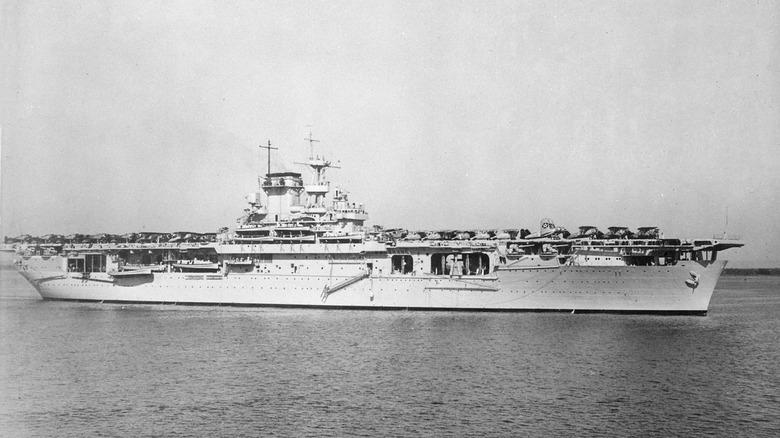5 Of The Worst Aircraft Carriers In Military History
The aircraft carrier is a fearsome weapon that's more than just a warship — it's a symbol of national pride, a show of force that can be deployed to any theater of war. At least, it should be, but it doesn't always work like that. While the engineering and know-how that produces mighty carriers like the USS Gerald R. Ford — the world's most advanced aircraft carrier — is simply mind-boggling, when designers and engineers get it wrong, the results can boggle minds for all the wrong reasons.
This article looks at five aircraft carriers that, instead of becoming a source of national pride, became a cause for national shame. From smoke-belching Russian breakdown machines like the Admiral Kuznetsov to the Japanese Shinano, a lightly armored giant of a ship, history is littered with aircraft carriers that didn't live up to the hype. The carrier's distinguished history stretches back to almost as soon as the Wright brothers first took to the air in 1903. The first true carrier was the British HMS Argus, which was developed from a converted freighter during WW1. The first American carrier — the USS Langley — entered service in 1922. Neither of these was bad enough to make the list, but since then, history has supplied us with plenty of other dreadful aircraft carriers that are definitely worthy of a place.
Admiral Kuznetsov - A heavy smoker
Russia maintains a formidable navy that is the world's third biggest. Its fleet includes 79 submarines and 222 warships. Of which, the Admiral Kuznetsov is the sole aircraft carrier. To say the Kuznetsov has a checkered history would be a massive understatement. There are plenty of reasons why the Admiral Kuznetsov is considered one of the worst aircraft carriers ever built. The ship was launched in 1985, with commissioning following in 1991. Since then, it has been seriously underwhelming. Unlike the nuclear-powered behemoths that the US Navy operates, the Kuznetsov runs on Mazut. Mazut is a thick tar-like fuel, that creates an equally thick and unpleasant smoke when burned. Additionally, the ship's steam turbines were so unreliable that a tug followed it wherever it went.
It wasn't even particularly good at its primary task — as a base for air operations. Despite being 1,000 feet long, it launches aircraft using a bow ramp instead of a steam catapult system. This restricts the weight of the aircraft and the fuel they can carry and therefore shortens missions. During a mission in 2009, one seaman died in a fire, and the ship spewed hundreds of tons of Mazut into the Mediterranean Sea during refueling (it had to refuel every 45 days). Ultimately, the one-time Russian Navy flagship went in for repairs in 2018. Amid these, fires killed two workers and caused serious damage. Oh, and a seventy-ton crane crashed through the flight deck. It's unclear as to whether it will take to sea again.
The Shinano - The Titanic of aircraft carriers
There are certain ships that become legends for all the wrong reasons. The Titanic is one such ship, and for very similar reasons, the WW2 Japanese carrier the Shinano can be added to the list. The Shinano didn't even begin life as an aircraft carrier; when her keel was first laid, she was intended as a battleship. However, with the Japanese carrier fleet suffering losses at the Battle of Midway, and a diminishing role for battleships at sea, the decision was made to repurpose the partially built Shinano as the world's biggest aircraft carrier. What could possibly go wrong?
Quite a lot, as it happens. First, there was the ill-thought-out concept of turning her not into a true combat aircraft carrier, but into a carrier support ship. The intention was to use her as a supply vessel for other carriers. Including supplying fuel, ammunition, and aircraft. Although, she did carry 48 fighters for self-defense. She also featured a formidable array of anti-aircraft defenses and an armored flight deck. So far, so good. It's under the waterline where the ship's Achilles heel is apparent. Lightly armored, the Shinano — like all aircraft carriers — was vulnerable to attack from submarines. Ultimately, luck wasn't on her side, and this is exactly what happened seven hours into her maiden voyage. The American submarine, USS Archerfish, struck the Shinano with four torpedoes. The ship sank seven hours later, despite efforts to beach her. She remains the largest ship ever to be sunk by a submarine.
The Liaoning - A Chinese Admiral Kuznetsov
Before the Liaoning even entered service as China's first aircraft carrier, the ship's history had already had its fair share of subterfuge and intrigue. To understand why, we need to look back at the carrier's roots. The ship was intended to be Russia's second Admiral Kuznetsov-class aircraft carrier. However, when the Soviet Union collapsed, the ownership of the unfinished carrier fell to Ukraine. The ship was promptly sold to a Macau-based company to be — seemingly — operated as a floating casino. Instead, she ended up in the hands of the Chinese government and was eventually refitted for her original purpose. Unfortunately, many of the same traits from the original Kuznetsov were apparent in the Chinese remodelling of the ship.
The ship lacks a steam catapult and uses a ramp system to launch its aircraft, with the same associated issues that blighted the Kuznetsov. For the heavyweight J-15 Chinese carrier-based fighter, this meant that fighters had to be launched to act as tankers to other J-15s. Additionally, although the Liaoning doesn't use Mazut, it still runs on steam and requires refuelling every 45 days. However, even though the carrier uses heavy fuel oil as opposed to Mazut, she still has a tendency to emit plumes of black smoke when under power. Indeed, it's estimated that during a five-day visit to Hong Kong, the Liaoning emitted about the same amount of pollutants as half a million cars would.
Charles de Gaulle - Improved after a shaky start
On paper, it would seem a little harsh to place the French Charles de Gaulle carrier on the list. It is, after all, the only nuclear-powered submarine that isn't American. However, despite having a service life that now numbers 25 years, the carrier has had its share of problems and controversy. First, let's look at its size: the USS Gerald R. Ford — the largest aircraft carrier in the world — displaces about 100,000 tons, and the Charles de Gaulle displaces 42,500 tons. While size isn't everything, the diminutive stature immediately caused problems when it became apparent that the flight deck wasn't long enough to launch the E-2 Hawkeye.
Then there was the nuclear problem – inadequate shielding saw higher than acceptable onboard radiation levels. Additionally, the nuclear reactor design used in the ship needs to be refueled every seven years. It takes an incredibly long time to refuel a nuclear aircraft carrier, which is why American carriers are designed to only need refueling once in a projected 50-year lifespan.
The ship's propellers also caused problems. Flawed manufacturing techniques created an intense vibration that ultimately resulted in one of the propellers shattering completely. To compound the problem, the original blueprints for the propellers were lost in a fire, and the inferior "hand-down" replacements knocked her top speed down from 27 knots to 24 knots. Not good when the optimum top speed was already slower than her predecessors. Despite its flaws, the Charles de Gaulle is still in active service.
USS Wasp - A compromise too far
The USS Wasp was designed to keep the US Navy on the good side the Washington Naval Treaty. This restricted the United States Navy to an overall size of 525,000 tons. The treaty also specified that the tonnage allocated to aircraft carriers was 135,000 tons, with no carrier exceeding 27,000 tons. At the time she was authorized in 1934, the remaining tonnage that could be allocated to the project was 14,700 tons. For comparison, the similar-era USS Yorktown displaced 19,800 tons. To shed this amount of weight, compromises had to be made.
One place where the ship's designers opted to shed weight was the armor. Even critical parts like magazines, rudder control, and aviation fuel storage were only covered by a maximum of four inches of armor. In less critical areas, this dropped down to 0.75 inches, with the conning receiving a slightly better 1.5 inches. Other design issues included a hull that was only strengthened to the hangar deck, and an inadequate fire control system. It was the latter that was to prove the carrier's undoing. In September 1942, the Wasp was torpedoed by a Japanese submarine while taking part in supporting actions at Guadalcanal. The subsequent fires caused so much damage that the carrier was scuttled by the USS Lansdowne. Ultimately, a naval report found that inadequate firefighting facilities, a still active fuel storage system, and poor water pressure, were among the factors that contributed to the loss of the ship.
